Embark on a fascinating exploration of North Carolina’s diverse birding landscape with our comprehensive guide. This Ultimate Guide highlights the 37 most common birds found throughout the Tar Heel State, offering detailed insights into their habitats, behaviors, and distinctive characteristics.
Whether you’re a dedicated birder, an outdoor enthusiast, or simply curious about North Carolina’s unique birdlife, this guide provides a captivating exploration of the avian wonders that grace this scenic state.
Table of Contents
- 1 Most Common Birds of North Carolina
- 1.1 Northern Cardinal
- 1.2 Carolina Wren
- 1.3 Carolina Chickadee
- 1.4 Tufted Titmouse
- 1.5 American Crow
- 1.6 Mourning Dove
- 1.7 Red-bellied Woodpecker
- 1.8 Blue Jay
- 1.9 American Robin
- 1.10 Eastern Bluebird
- 1.11 Eastern Towhee
- 1.12 Downy Woodpecker
- 1.13 Northern Mockingbird
- 1.14 American Goldfinch
- 1.15 House Finch
- 1.16 Song Sparrow
- 1.17 White-breasted Nuthatch
- 1.18 White-throated Sparrow
- 1.19 Yellow-rumped Warbler
- 1.20 Chipping Sparrow
- 1.21 Eastern Phoebe
- 2 Author
Most Common Birds of North Carolina
Northern Cardinal
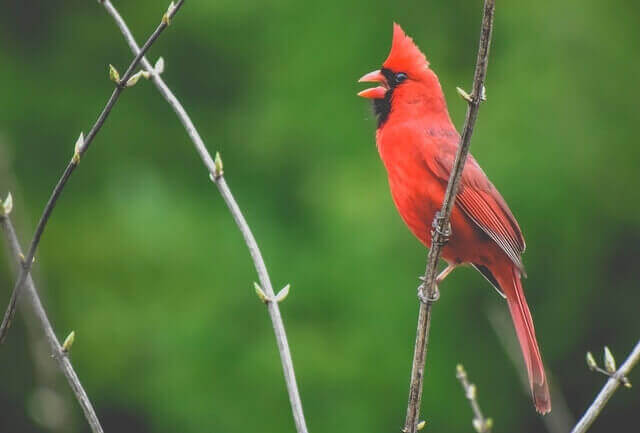
The Northern Cardinal is a red bird found in the eastern United States. They are usually seen near woodland edges, hedgerows, and other semi-open areas with dense undergrowth. They feed on insects and seeds from a variety of plants including clover, dandelions, and grasses.
Cardinals typically migrate south to warmer climates during winter months, but will remain north if there is an ample food supply. The Northern Cardinal’s range extends from North Carolina through Kentucky into Illinois.
- Frequency: 60.67% (Statistic by: eBird)
- Color: Mostly red with a black mask on the face
- Habitat: woodlands, gardens, parks, backyards, and wetlands
- Range: USA, Canada, Mexico
- Size: 8.2 – 9.3″ inches
- Weight: 33 – 65 grams
- Diet: Fruits, berries, and insects (grasshoppers, beetles, snails, cicadas)
- Family: Cardinalidae
- Genus: Cardinalis
- Maps: Range Map – Sightings Map
- Sounds: Calls and Songs
Related Posts:
Carolina Wren
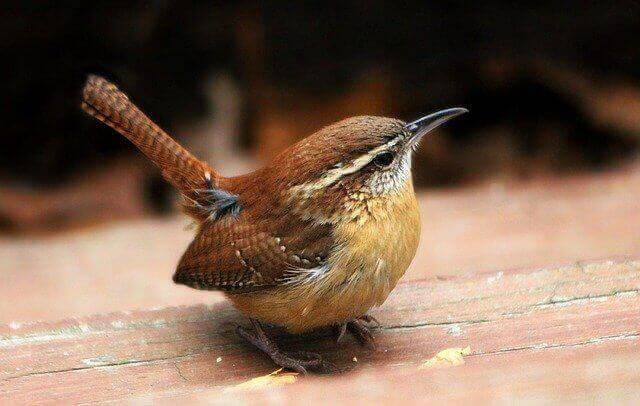
The Carolina Wren is a very small bird that lives in North America. The range of the Carolina wren extends from northern Canada to Florida and west to Texas. They prefer deciduous forests, grasslands, suburbs and parks where there are large trees or shrubs for nesting.
The diet of the Carolina wren consists mainly of insects such as ants, beetles, crickets and spiders but also eats some fruit and seeds when available. They do not migrate, but may travel locally depending on food availability or habitat changes like storms.
- Frequency: 53.86%
- Color: Reddish-brown upper and buff-orange color under, with a white chin, throat. White stripe on the eyebrow.
- Habitat: woodlands, gardens, parks, backyards, and wetlands
- Range: USA, Canada, Mexico
- Size: 5.0 – 5.5″ inches long
- Weight: 18 – 23 grams
- Diet: Fruits, berries seeds, and insects (Caterpillars, beetles, true bugs, grasshoppers, crickets, spiders, millipedes, snails)
- Family: Troglodytidae
- Genus: Thryothorus
- Maps: Range Map – Sightings Map
- Sounds: Calls and Songs
Carolina Chickadee
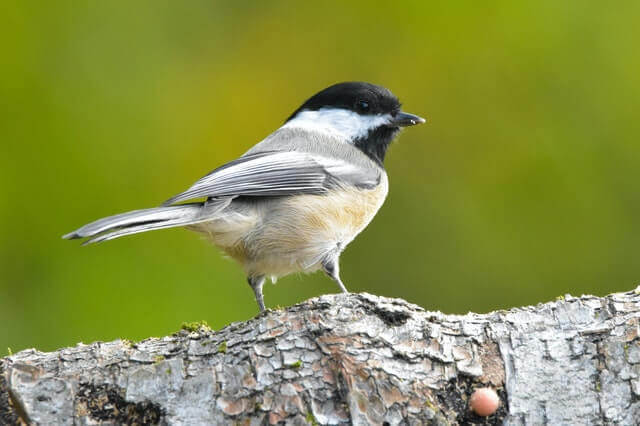
The Carolina Chickadee is a small bird that can be found in Eastern North America. It ranges from southern Canada to northern Mexico but mostly inhabits deciduous forests in the Eastern United States of America and into southern Ontario and Michigan.
The Carolina Chickadee eats small insects such as ants, beetles, caterpillars and spiders. They also eat fruits like cherries, mulberries and blueberries. They migrate south for winter months into parts of Central America.
- Frequency: 52.92%
- Color: Black cap and throat with white cheeks. Light gray wings, back, and tail.
- Habitat: Deciduous forests, suburbs, parks, backyards
- Range: USA ( Texas, Florida, New Jersey, and Kansas)
- Size: 4.5 – 5.1″ inches long
- Weight: 9 – 12 grams
- Diet: Insects, berries, seeds
- Family: Paridae
- Genus: Poecile
- Maps: Range Map – Sightings Map
- Sounds: Calls and Songs
Related Post:
- Best Bird Feeder For Chickadees (The Ultimate Guide 2022)
- Carolina Chickadees – 9 Best Ways To Attract Them Fast!
Tufted Titmouse
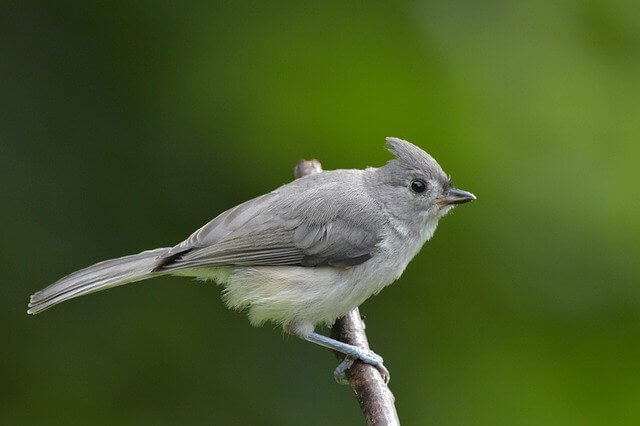
The Tufted Titmouse is a medium-sized bird found in North America. They live year round in deciduous and mixed forests of the eastern United States, extending into the Rocky Mountains to northern Mexico. The Titmouse ranges from Canada to Mexico, but does not cross open water.
It prefers woodland habitats, including forests, woodlands, scrubland, fields and suburban gardens with trees or hedges. Titmice are mainly insectivores, but will also eat seeds and berries, as well as nectar and insects. Titmice migrate during the winter. The breeding season is typically March through July.
- Frequency: 47.81%
- Color: Gray upper, white front, a tufted gray crest on the head
- Habitat: Deciduous forests, river basin, backyards, swamps
- Range: Canada, USA, and Mexico
- Size: 5.5 – 6.4″ inches
- Weight: 18 – 26 grams
- Diet: Nuts, insects, berries, seeds small fruit, and snails
- Family: Paridae
- Genus: Baeolophus
- Maps: Range Map – Sightings Map
- Sounds: Calls and Songs
Related Post: How to Attract Tufted Titmouse to my Yard
American Crow
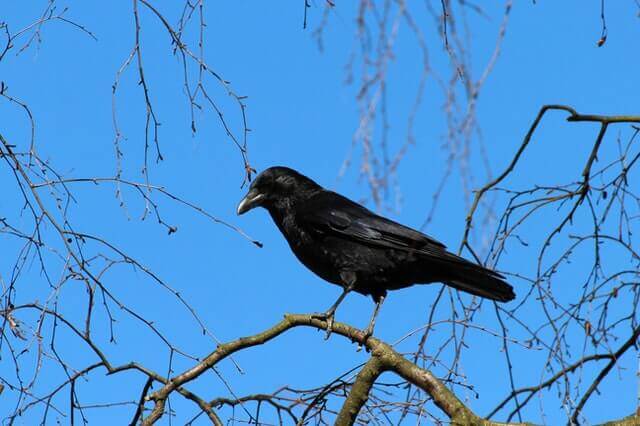
The American Crow is the largest species of the crow in the eastern part of North America. They are the second most common migratory bird in the eastern United States. The bird has been recorded from all parts of the state, ranging from small islands along the coast to large mountains on the interior.
Many records have been made of the bird’s migration from southern Ontario and into the Carolina’s. The American Crow’s occupying most of the open places in the state, including swamps, marshes, and rivers. They nest in hollow trees and on tree stumps and in tree hollows.
- Frequency: 46.17%
- Color: Black
- Habitat: Open country, farms, parks, woodlands, towns, cities
- Range: Canada, USA, Mexico
- Size: 16 – 21″ inches
- Weight: 315 -620 grams
- Diet: invertebrates, carrion, seeds, eggs fish, grains, mice, frogs, and other small animals.
- Family: Corvidae
- Genus: Corvis
- Maps: Range Map – Sightings Map
- Sounds: Calls and Songs
Mourning Dove
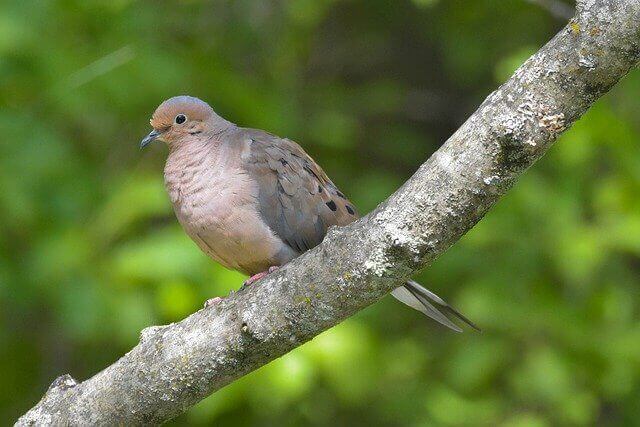
The Mourning Dove is a common bird found in North America. It breeds from the eastern United States west to central Texas and south to Mexico, Central America, and Colombia. They are primarily permanent residents of the US. This bird prefers habitats with moist soil like swamps or wet meadows where they feed on earthworms, insects, crustaceans and seeds.
Their migration pattern depends on their location; those that breed in northern areas may migrate south for winter, while those breeding in southern regions may stay in their breeding area year-round.
- Frequency: 42.75%
- Color: Light gray-brown and lighter and pinkish below. The wings have black spots.
- Habitat: Open habitats, urban areas, farms, prairie, grassland, wooded area
- Range: USA, Canada, Mexico, Central America, Greater Antilles
- Size: 12″ inches length
- Weight: 112 – 170 grams
- Diet: Rapeseed, corn, millet, safflower, sunflower seeds, pokeberry, sesame, and wheat.
- Family: Columbidae
- Genus: Zenaida
- Maps: Range Map – Sightings Map
- Sounds: Calls and Songs
Red-bellied Woodpecker
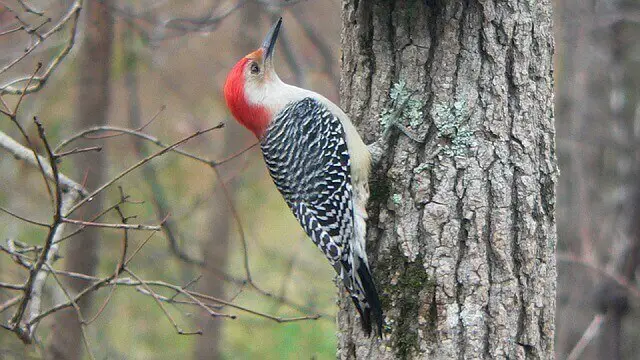
The red-bellied woodpecker is a bird that inhabits North America. They can be found in most parts of the United States, Canada and Mexico, with exception to some mountainous regions. The range for this species is mostly within deciduous forests, but also includes other areas such as parks, golf courses and suburban yards.
They are mainly insectivores and their diet consists of ants, termites, caterpillars, beetles larvae etc. Red-bellied Woodpeckers will migrate to avoid cold weather during the winter months and return again when it gets warmer.
- Frequency: 39.25%
- Color: Gray on body and face and underparts. Black and white pattern on wings, back, and tail.
- Habitat: Forests, backyards
- Range: Southern Canada, Eastern United States, Florida
- Size: 9 – 10.6″ inches long
- Weight: 56 -91 grams
- Diet: Insects, tree frogs, eggs of small birds, oozing sap, and small fish.
- Family: Picidae
- Genus: Melanerpes
- Maps: Range Map – Sightings Map
- Sounds: Calls and Songs
Related Post: How to Attract Red-bellied Woodpeckers to your Yard?
Blue Jay
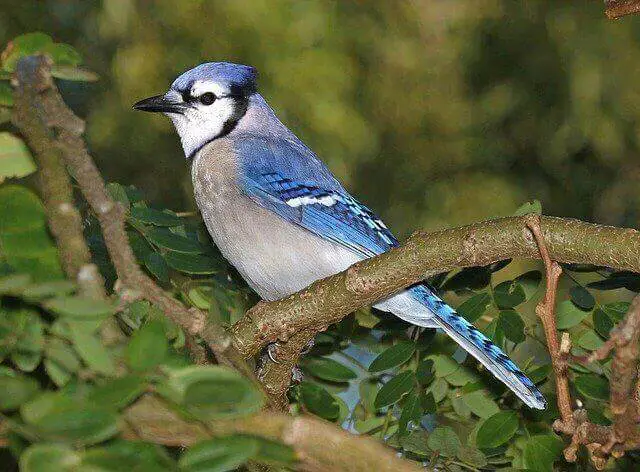
The Blue Jay is a bird that can be found throughout North America. It is usually located in habitats such as deciduous forests, coniferous forests, and woodlands. The diet of the blue jay consists mainly of nuts, seeds, fruits and insects.
In addition to this diet they also feed on small animals like frogs or snakes as well as eggs from other birds’ nests. Jays migrate south for winter when their food sources become scarce due to harsh weather conditions, but they return north once warmer temperatures arrive.
- Frequency: 38.89%
- Color: Blue crest on the head, wings, back, and tail, and has a white face and belly
- Habitat: Deciduous and mixed forests, mixed woodlands, backyards, parks
- Range: Southern Canada, Eastern and Central United States, Florida and Texas
- Size: 8 – 12″ inches
- Weight: 70 – 100 grams
- Diet: Nuts, seeds, caterpillars, grasshoppers, and beetles
- Family: Corvidae
- Genus: Cyanocitta
- Maps: Range Map – Sightings Map
- Sounds: Calls and Songs
Related Posts:
- How to Attract Blue Jays to your Yard?
- Do Blue Jays Migrate? The Truth
- What do Blue Jay Eat – All The Facts
American Robin
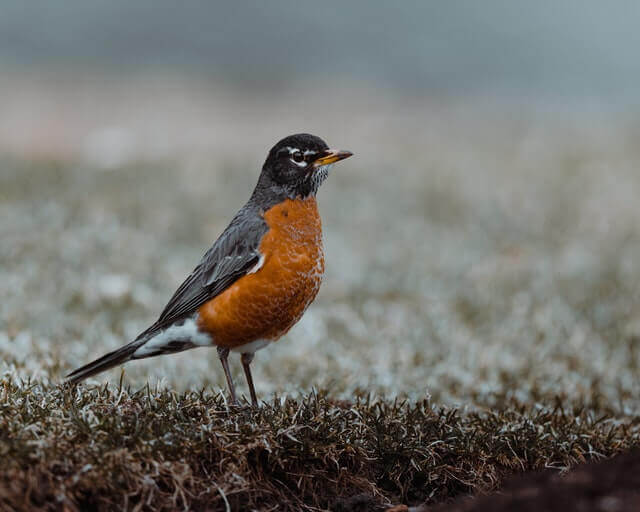
The American Robin is a migratory songbird that breeds in eastern North America, with populations in the east of Canada and throughout the Eastern United States. They migrate to Mexico and Central America for winter. This bird has an extremely large range, which includes eastern North America from Maine to Florida and west to Texas.
Their habitat consists mainly of woodland edges, fields, parks and gardens as well as forest edges during migration season. Robins eat insects and berries year-round. They also eat earthworms, spiders, centipedes and slugs in the summer months when they are most abundant.
- Frequency: 34.08%
- Color: Mostly brown on the back with an orange-colored breast
- Habitat: Wooded areas, backyards, parks, fields
- Range: USA, Canada, Mexico
- Size: 12 – 16″ inches in length
- Weight: 72 – 95 grams
- Diet: Fruits, berries, and insects (earthworms, beetles, caterpillars
- Family: Turdidae
- Genus: Turdus
- Maps: Range Map – Sightings Map
- Sounds: Calls and Songs
Related Post: Interesting American Robin Fun Facts
Eastern Bluebird
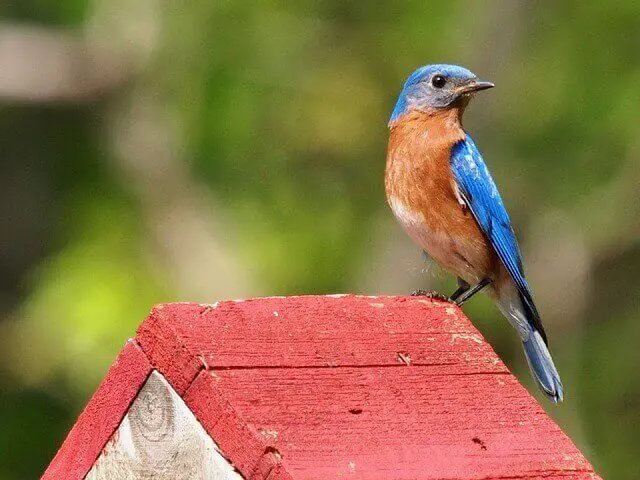
The Eastern Bluebird is a small bird that resides in North America. The Eastern Bluebird’s range includes southern Canada, the eastern United States and northern Mexico. They are found mostly in deciduous forests and agricultural areas.
Their diet consists mainly of insects during summer months, but they will eat berries when available in winter time. Their migration pattern varies depending on where they live; for example some may migrate south to warmer climates during winter while others will stay put throughout the year.
- Frequency: 33.61%
- Color: A blue head, back, and wings with a reddish-brown breast.
- Habitat: Open woodlands, farmlands, and orchards.
- Range: Southern Canada to the Gulf states, East of the Rockies and south to Arizona to Nicaragua
- Size: 5.5 – 7.1″ inches in length
- Weight: 20 – 33 grams
- Diet: insects and other invertebrates
- Family: Turdidae
- Genus: Sialia
- Maps: Range Map – Sightings Map
- Sounds: Calls and Songs
Related Post: How to Attract Eastern Bluebirds to your Yard (Explained)
Eastern Towhee
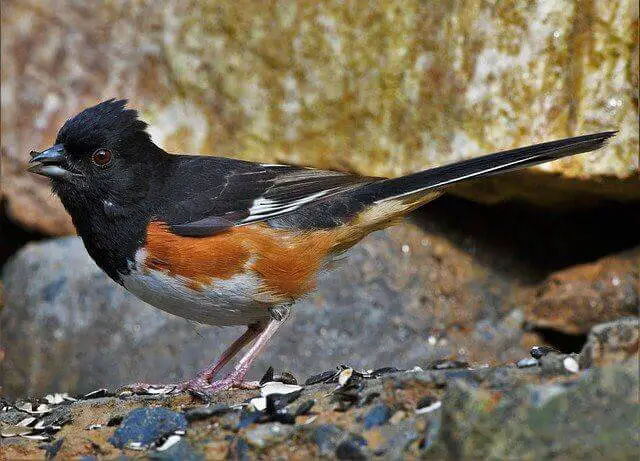
The Eastern Towhee is a member of the sparrow family and has a range that stretches from southern Canada to northern South America. The Eastern Towhee’s habitat consists mainly of woodlands, gardens, parks and hedgerows with brushy areas for nesting sites.
The diet of the Eastern Towhee is mostly insects, but also includes small fruits such as berries and seeds. It will occasionally eat caterpillars or other types of bugs it finds in its habitat during migration periods when food may be scarce. The Eastern Towhee migrates south during winter months to avoid cold weather.
- Frequency: 32.93%
- Color: A Black head, upper body, and tail, reddish-brown sides, a white belly, and a long dark tail with white edges
- Habitat: Deciduous forests and thickets, roadside, grasslands, backyards, parks
- Range: Eastern USA and Canada
- Size: 6.8 – 9.1″ long
- Weight: 32 – 53 grams
- Diet: insects and other invertebrates occasionally small amphibians, snakes, and lizards
- Family: Passerellidae
- Genus: Pipilo
- Maps: Range Map – Sightings Map
- Sounds: Calls and Songs
Related Post: How to Attract Towhee to your Backyard? Expert Tips!
Downy Woodpecker
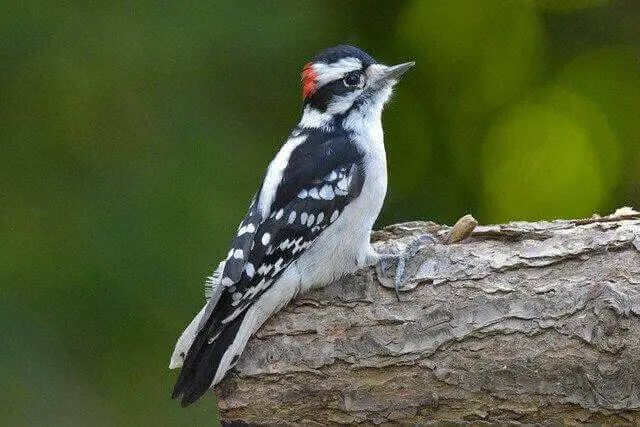
The Downy Woodpecker is a North American bird that ranges from Canada to the United States. They are mostly found in deciduous forests and will only occupy areas with a large amount of dead wood for nesting. The diet of the Downy Woodpecker consists mainly of insects, but they will also eat nuts, berries, and seeds.
The Downy Woodpeckers have an annual migration pattern that includes movement as far south as Panama during winter months.
- Frequency: 31.98%
- Color: Black with a white throat, belly, and back. White spots on wings
- Habitat: Deciduous forests and thickets, roadside, grasslands, backyards, parks
- Range: Canada, USA, and Mexico
- Size: 5.5 – 7.1″ inches in length
- Weight: 20 – 33 grams
- Diet: Mostly insects and beetles and ants, also gall wasps, caterpillars
- Family: Picadae
- Genus: Dryobates
- Maps: Range Map – Sightings Map
- Sounds: Calls and Songs
Related Post: How to Attract Downy Woodpeckers to Your Yard? (Easy!)
Northern Mockingbird
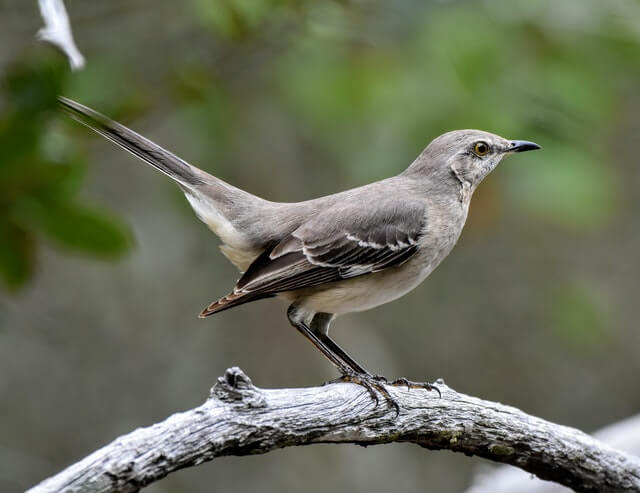
The Northern Mockingbird is a bird of the Mimidae family, which means it is related to mockingbirds and thrashers. The Northern Mockingbird is a common bird found in the Eastern United States.
The bird’s range extends from North Carolina to Maine and as far west as Iowa, Kansas, Missouri and Texas. It can be found in woodlands, thickets, suburban areas and gardens where it eats insects, earthworms, and small vertebrates like lizards or frogs.
- Frequency: 31.49%
- Color: Gray upper with white underparts. Black and white wing bars.
- Habitat: Forested areas, parks, and gardens
- Range: Southeastern Canada, USA, Northern Mexico, Cayman Islands, Greater Antilles
- Size: 8.0 – 11″ inches long
- Weight: 40 – 58 grams
- Diet: Berries, fruits, seeds, arthropods, earthworms, and occasionally lizards
- Family: Mimidae
- Genus: Mimus
- Maps: Range Map – Sightings Map
- Sounds: Calls and Songs
Related Post: How to Attract Mockingbirds to your Yard? (Expert Tips)
American Goldfinch
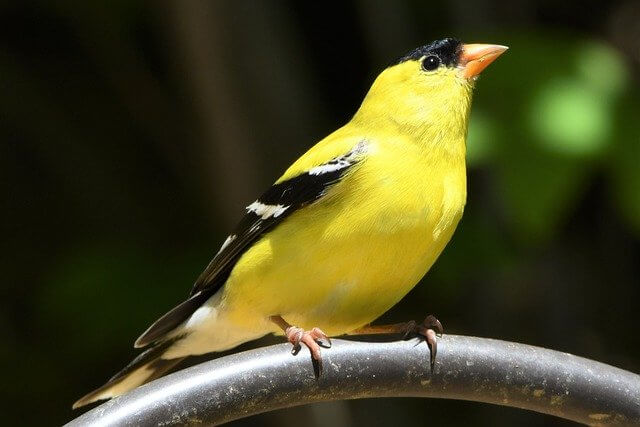
The American Goldfinches are found in most of North America. They live in the woodlands, hedgerows and thickets throughout the United States and Canada. These little birds are typically found in open fields or meadows where they feed on seeds from plants such as clover, thistle, dandelion and crabgrass. They will also eat insects when available.
The American Goldfinch has one of the longest migrations out of any North American bird with an average flight distance of 1500 miles each way. The birds will start heading south in August and will fly about 50 miles a day until they reach their wintering ground in Central America.
- Frequency: 31.15%
- Color: Face, neck, and underside are yellow, black wings with white bars
- Habitat: Deciduous forests and thickets, roadside, grasslands, backyards, meadows
- Range: Canada, USA, and Mexico
- Size: 4.3 – 5.5″ inches length
- Weight: 12 -18 grams
- Diet: Grass, dandelions, chickweed, sunflowers and ragweed, thistle, red alder, birch, spruce seeds
- Family: Carduelinae
- Genus: Spinus
- Maps: Range Map – Sightings Map
- Sounds: Calls and Songs
Related Post: Interesting American Goldfinch Facts You Need to Know!
House Finch
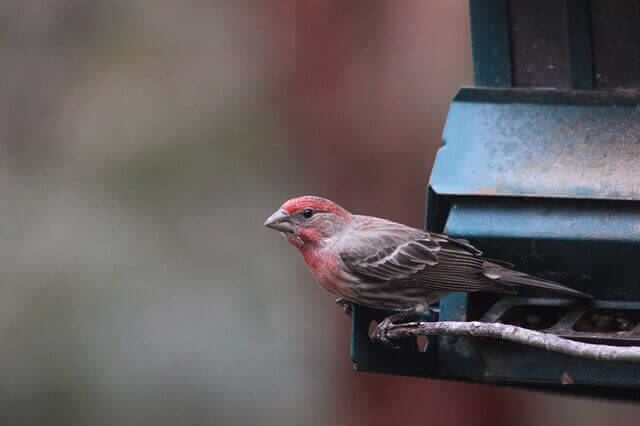
The House Finches are common in North America and can be found as far north as the Arctic Circle. They range south to Panama, but their populations are sparse below Arizona and New Mexico. The majority of the population is concentrated between Kansas and South Carolina.
The House Finch typically lives around humans where it can find food for its diet which consists mainly of seeds from weeds or grasses but will also eat insects and some fruit. House Finches are common all year round but there are migratory populations which fly south during winter months for warmth.
- Frequency: 27.12%
- Color: Reddish face and upper breast, brown streaks on back, belly, and tail.
- Habitat: urban and suburban areas, backyards, edges, yards, and parks
- Range: Canada, USA, Mexico
- Size: 5 – 6″ inches
- Weight: 16 – 27 grams
- Diet: Aphids, grains, seeds, berries, nettle, dandelion, sunflower
- Family: Fringillidae
- Genus: Haemorhous
- Maps: Range Map – Sightings Map
- Sounds: Calls and Songs
Related Post: How to Attract House Finch to your Yard
Song Sparrow

The Song Sparrow is a small, brown sparrow with distinctive streaks on its head. They are found in the eastern and central United States and can be seen at anytime of year, although they migrate south for the winter. The Song Sparrow has a range from Alaska to Nova Scotia and as far west as Texas.
In summer their habitat is primarily rural areas or farms where there are fields, brushy areas or hedgerows; in winter it’s forests with shrubs and tall trees that provide cover. Their diet consists mainly of insects during the summer months and seeds during the winter months.
- Frequency: 25.29%
- Color: Gray head, white cheek, a black bib, rufous neck
- Habitat: Urban centers, farms, backyards, edges, yards, and parks
- Range: Europe, Mediterranean, Asia, Australasia, Africa, and the Americas
- Size: 5.5 – 7.0″ inches
- Weight: 25 – 40 grams
- Diet: Grains, seeds, and insects
- Family: Passeridea
- Genus: Passer
- Maps: Range Map – Sightings Map
- Sounds: Calls and Songs
Related Post: How to Attract Sparrows to your Backyard
White-breasted Nuthatch
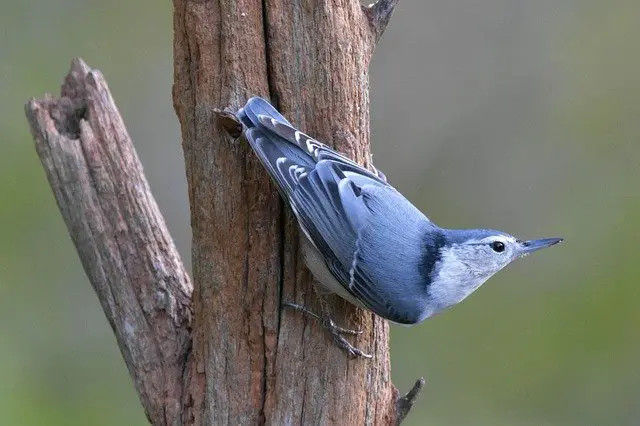
The White-breasted Nuthatches range from southern Canada to Central America. They live in coniferous and deciduous forests, with some preferring the temperate climates of the Northern Hemisphere and others preferring tropical habitats of the Southern Hemisphere. Their diet includes insects, berries, seeds, nuts and tree sap.
They migrate south for winter, but return north as soon as spring arrives. Some populations remain in their breeding area year round. They migrate to southern areas of the United States as well as Central America during winter time when food is scarce due
- Frequency: 23.29%
- Color: A White face, flanks, and chest. It has a black cap on its head a bluish-gray upper and a brown belly
- Habitat: Deciduous forests, conifers, roadside, rivers, backyards, parks
- Range: Southern Canada, USA
- Size: 5.9″ inches
- Weight: 20 grams
- Diet: Acorn nuts, hickory nuts, ants, caterpillars, scale insects, pine weevils
- Family: Sittidae
- Genus: Sitta
- Maps: Range Map – Sightings Map
- Sounds: Calls and Songs
Related Post: How to Attract Nuthatches to your Backyard
White-throated Sparrow
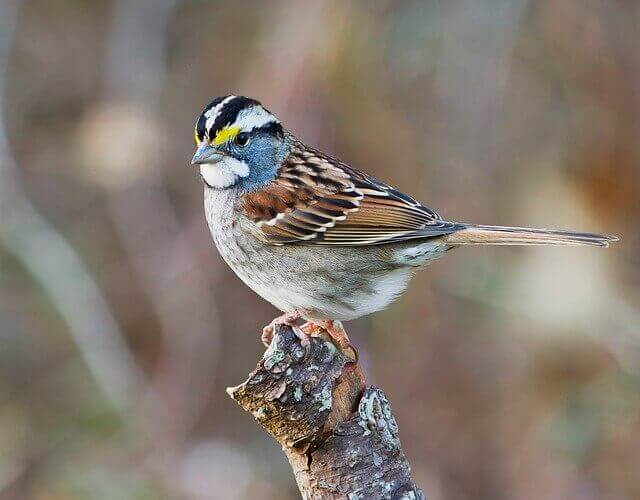
The White-throated Sparrow is a common bird in North America, and can be found in most of the United States and Canada. The white-throated sparrows are usually seen during springtime when they migrate to breed their offspring for the summer.
Their habitat ranges from grasslands to forest edges, parks and gardens. These birds feed on insects, seeds, berries and some other food sources that it finds while searching for its prey.
- Frequency: 20.66%
- Color: Brown and gray head pattern. Black-and-white-striped head, white throat, and yellow near the eye.
- Habitat: Deciduous forests and thickets, roadside, grasslands, backyards
- Range: Eastern North America, Atlantic Canada
- Size: 5.9″ – 7.5″ inches long
- Weight: 22 – 32 grams
- Diet: Seeds, insects, and berries
- Family: Passerellidae
- Genus: Zonotrichia
- Maps: Range Map – Sightings Map
- Sounds: Calls and Songs
Yellow-rumped Warbler
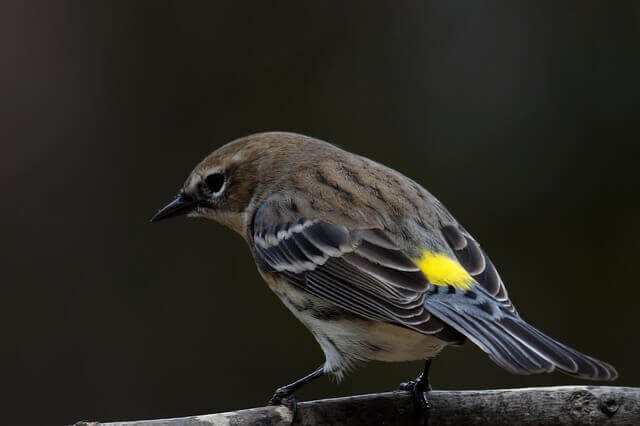
The Yellow-rumped Warbler is a migratory bird found in North America. They are very common and have a widespread range. These birds usually migrate to the Central American coast for winter, but some stay in the northern regions of Canada all year round.
The most populous area for these birds is eastern North America where they live among coniferous trees or any other place with dense vegetation such as bogs, fens, and meadows. Their diet consists of insects such as flies, mosquitoes and ants, but also berries from bushes or trees if they can find them.
- Frequency: 19.17%
- Color: Yellow patches on the crown, flanks, rump & blackish-blue streaks on the back, breast, and wings
- Habitat: Deciduous forests and thickets, roadside, grasslands, backyards
- Range: U.SA, Canada, Mexico, Central America, and the Caribbean
- Size: 4.7 – 5.9″ inches
- Weight: 10 – 18 grams
- Diet: grasshoppers, gnats, aphids, caterpillars, wasps, beetles, spiders, berries,
- Family: Parulidae
- Genus: Setophaga
- Maps: Range Map – Sightings Map
- Sounds: Calls and Songs
Related Post: How to Attract Warblers to you Yard?
Chipping Sparrow

The Chipping Sparrow is a very common and widespread species of sparrow in North America. The chipping sparrow has an extensive range that includes the southern Canada, United States, Mexico, Central America and the Caribbean. The chipping sparrow inhabits a variety of habitats including agricultural fields, grasslands and brushy areas as well as open woodlands.
The Chipping Sparrow feeds on insects including caterpillars, grasshoppers and beetles as well as seeds from plants. In late winter they migrate southwards through Texas into central Mexico for the winter months then return northward as early as March or April
- Frequency: 19.08%
- Color: Rust-colored upperparts, gray head, and underparts with a reddish cap on the head
- Habitat: Coniferous forests, woodland, farmland, parks, and gardens
- Range: Southern USA and Mexico
- Size: 4.7 – 5.9″ inches
- Weight: 11 – 16 grams
- Diet: Mostly seeds, spiders
- Family: Passerellidae
- Genus: Spizella
- Maps: Range Map – Sightings Map
- Sounds: Calls and Songs
Eastern Phoebe
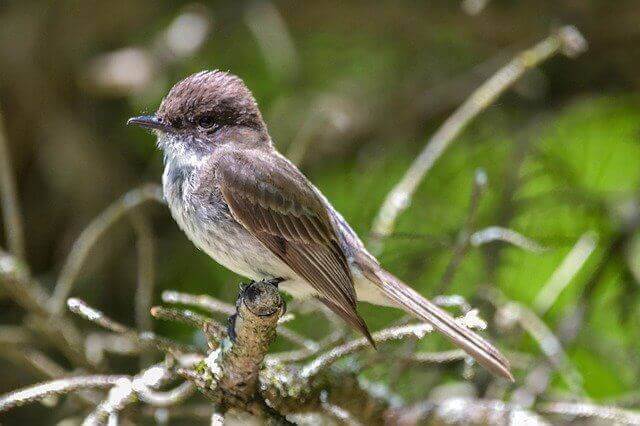
Eastern phoebes are small migratory birds that nest in the ground near bodies of water during spring and summer months. They winter in Central America, where they spend their time resting on lakes or ponds for food and protection from predators.
Eastern phoebes feed primarily on flying insects such as flies, bees, wasps, butterflies and dragonflies which they capture by hovering over the surface of a body of water and then diving in a swift motion with its mouth open.
- Frequency: 17.86%
- Color: Gray-brown upper, gray breast and underbody, white throat
- Habitat: Farmland, parks, and gardens
- Range: Southern USA and Mexico
- Size: 5.5 – 6.7″ inches long
- Weight: 16 – 21 grams
- Diet: Insects and berries
- Family: Tyrannidae
- Genus: Sayornis
- Maps: Range Map – Sightings Map
- Sounds: Calls and Songs
These backyard birds all have a frequency of less than 17% Year-round
- European Starling 17.49%
- Brown-headed Nuthatch 16.98%
- Pine Warbler 16.75%
- Common Grackle 16.48%
- Dark-eyed Junco 16.06%
- Northern Flicker 15.02%
- Red-winged Blackbird 14.81%
- Gray Catbird 13.95%
- Blue-gray Gnatcatcher 12.49%
- Ruby-throated Hummingbird 12.44%
- Double-crested Cormorant 12.17%
- Pileated Woodpecker 12.00%
- Brown-headed Cowbird 11.22%
- Ruby-crowned Kinglet 10.99%
- Killdeer 10.92%
- Red-eyed Vireo 10.88%



